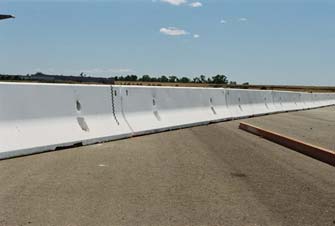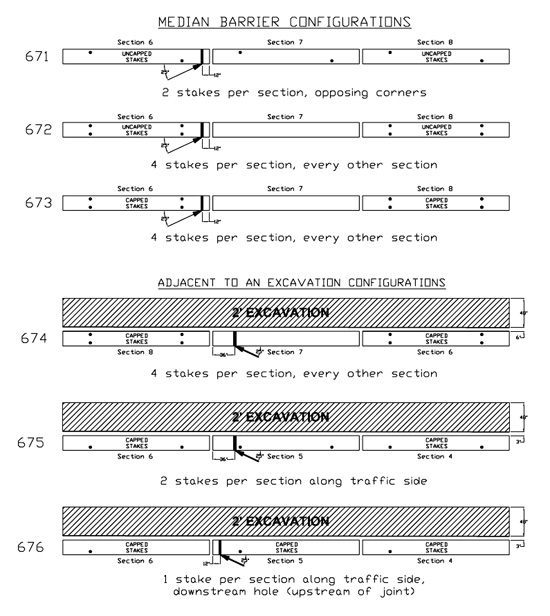Development of Staking Configurations for K-Rail
Background
 California's current standard for concrete temporary barrier is K-rail. This barrier, when properly installed, may also be used in semi-permanent applications. K-rail evolved from the Type 50 median barrier, which had been approved for use in California and other states since the mid-1960s. By 1971, there was substantial interest in the U.S. to develop a movable barrier that could be used in work zones. In 1972, the California Department of Transportation ran a series of crash tests on what is now called K-rail. The results of the testing led to the approval of K-rail for use as a temporary barrier in California. The K-rail that has become the standard within California consists of 6.1-m (20-ft) long sections with pin and loop connections, each weighing approximately 3630 kg (8000 lbs).
California's current standard for concrete temporary barrier is K-rail. This barrier, when properly installed, may also be used in semi-permanent applications. K-rail evolved from the Type 50 median barrier, which had been approved for use in California and other states since the mid-1960s. By 1971, there was substantial interest in the U.S. to develop a movable barrier that could be used in work zones. In 1972, the California Department of Transportation ran a series of crash tests on what is now called K-rail. The results of the testing led to the approval of K-rail for use as a temporary barrier in California. The K-rail that has become the standard within California consists of 6.1-m (20-ft) long sections with pin and loop connections, each weighing approximately 3630 kg (8000 lbs).
Eventually, details were developed which also allowed K-rail to be used as a semi-permanent barrier (2-5 years). The configuration of semi-permanent barrier required pin and loop connections between the K-rail segments as well as stakes at each of the four stake holes located in the K-rail. The configuration passed NCHRP Report 350 criteria, but removing the stakes from a paved surface led to expensive repairs and increased worker exposure.
An effort is being made to discover the minimum number of stakes and distance that a K-rail barrier can be placed adjacent to an excavation and as a median barrier before it is no longer compliant with NCHRP Report 350. Minimizing the number of stakes needed in order to achieve a NCHRP Report 350-compliant barrier will save money and worker exposure time.
Tested Staking Configurations

High Speed Crash Test Videos
| Test 671 | Test 672 | Test 673 | Test 674 | Test 675 | Test 676 |
|---|---|---|---|---|---|

